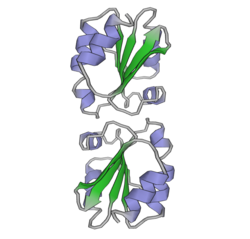チオレドキシン
チオレドキシン(thioredoxin)は、全ての生物に存在する低分子量の酸化還元タンパク質である。様々な生命反応において重要な役割を担っている。
| チオレドキシン | |
|---|---|
| 識別情報 | |
| KEGG | C00342 C00343 (ジスルフィド型) |
| 特記なき場合、データは常温 (25 °C)・常圧 (100 kPa) におけるものである。 | |
機能
編集チオレドキシンはヒトでは TXN 遺伝子にコードされている[5]。ヒトの場合、チオレドキシン遺伝子の機能喪失型突然変異体は、胚発生初期の四細胞期の時点で既に致死である。作用機構は完全に解明されているわけではないが、チオレドキシンはヒトにおいて中枢的な役割を果たしており、特に活性酸素種(ROS)との反応に関連して医薬分野との結びつきが強くなりつつある。前述の通りチオレドキシンは既知の全ての生物に見られるが、中でも哺乳類では不可欠である[6][7]。
植物においても、チオレドキシンは光合成から成長、花成、そして種子の形成と発芽に至るまで、多彩で重要な機能を司っている。近年では細胞シグナリングにも関与することが報告されている[8]。
作用機序
編集チオレドキシンは、他のタンパク質のシステイン残基が形成するジスルフィド結合の還元・切断を促進することで、抗酸化物質として機能する。アミノ酸配列のレベルでは、チオレドキシンは近接する2つのシステインからなる CXXC モチーフを持っていることで特徴付けられる。この2つのシステインはチオレドキシンの還元力の中核である。チオレドキシンはまたチオレドキシンフォールドと呼ばれる特徴的なフォールディング構造を持つ。他のタンパク質を還元した際、チオレドキシン自体は酸化され、自身のシステイン残基で分子内ジスルフィド結合を形成する。チオレドキシンは NADPH 依存性のフラビン酵素であるチオレドキシンジスルフィドレダクターゼによって還元され、再び還元力のある状態に保たれる[9]。
チオレドキシンはペルオキシダーゼやリボヌクレオチドレダクターゼに対して電子供与体として働く[10]。グルタレドキシンもチオレドキシンと似た機能を持っているが、この酵素は特定の還元酵素ではなくグルタチオンによって還元される。
- 酸化還元サイクルの概念図
- TrxR:チオレドキシン・ジスルフィド還元酵素
- FAD:フラボタンパク質
- S2:ジスルフィド結合
- Se:セレニウム
- Trx-S2:チオレドキシンジスルフィド
- Trx-(SH)2:チオレドキシン
- Protein:タンパク質等
相互作用
編集チオレドキシンは TXNIP(ThioredoXiN Interacting Protein )[11]、ASK1(Apoptosis Signal-regulating Kinase 1)[12][13][14]、コラーゲンIα[15]、そしてグルココルチコイド受容体[16] など、様々なタンパク質と相互作用することが知られている。
脚注・参考文献
編集- ^ a b c GRCh38: Ensembl release 89: ENSG00000136810 - Ensembl, May 2017
- ^ a b c GRCm38: Ensembl release 89: ENSMUSG00000028367 - Ensembl, May 2017
- ^ Human PubMed Reference:
- ^ Mouse PubMed Reference:
- ^ Wollman EE, d'Auriol L, Rimsky L, Shaw A, Jacquot JP, Wingfield P, Graber P, Dessarps F, Robin P, Galibert F (October 1988). “Cloning and expression of a cDNA for human thioredoxin”. J. Biol. Chem. 263 (30): 15506–12. PMID 3170595.
- ^ Holmgren A (1989). “Thioredoxin and glutaredoxin systems”. J Biol Chem 264 (24): 13963–6. PMID 2668278.
- ^ Nordberg J, Arnér E (2001). “Reactive oxygen species, antioxidants, and the mammalian thioredoxin system”. Free Radic Biol Med 31 (11): 1287–312. doi:10.1016/S0891-5849(01)00724-9. PMID 11728801.
- ^ Meng, Ling; Wong, Joshua; Feldman, Lewis; Lemaux, Peggy; Buchanan, Bob (2010). “A membrane-associated thioredoxin required for plant growth moves from cell to cell, suggestive of a role in intercellular communication”. Proceedings of the National Academy of Sciences of the USA 107 (8): 3900–5. doi:10.1073/pnas.0913759107. PMC 2840455. PMID 20133584.
- ^ Mustacich D, Powis G (February 2000). “Thioredoxin reductase”. Biochem J 346 (Pt 1): 1–8. doi:10.1042/0264-6021:3460001. PMC 1220815. PMID 10657232.
- ^ Arnér E, Holmgren A (2000). “Physiological functions of thioredoxin and thioredoxin reductase”. Eur J Biochem 267 (20): 6102–9. doi:10.1046/j.1432-1327.2000.01701.x. PMID 11012661.
- ^ Nishiyama, A; Matsui M, Iwata S, Hirota K, Masutani H, Nakamura H, Takagi Y, Sono H, Gon Y, Yodoi J (Jul. 1999). “Identification of thioredoxin-binding protein-2/vitamin D(3) up-regulated protein 1 as a negative regulator of thioredoxin function and expression”. J. Biol. Chem. (UNITED STATES) 274 (31): 21645–50. doi:10.1074/jbc.274.31.21645. ISSN 0021-9258. PMID 10419473.
- ^ Liu, Yingmei; Min Wang (Jun. 2002). “Thioredoxin promotes ASK1 ubiquitination and degradation to inhibit ASK1-mediated apoptosis in a redox activity-independent manner”. Circ. Res. (United States) 90 (12): 1259–66. doi:10.1161/01.RES.0000022160.64355.62. PMID 12089063.
- ^ Morita, K; Saitoh M, Tobiume K, Matsuura H, Enomoto S, Nishitoh H, Ichijo H (Nov. 2001). “Negative feedback regulation of ASK1 by protein phosphatase 5 (PP5) in response to oxidative stress”. EMBO J. (England) 20 (21): 6028–36. doi:10.1093/emboj/20.21.6028. ISSN 0261-4189. PMC 125685. PMID 11689443.
- ^ Saitoh, M; Nishitoh H, Fujii M, Takeda K, Tobiume K, Sawada Y, Kawabata M, Miyazono K, Ichijo H (May. 1998). “Mammalian thioredoxin is a direct inhibitor of apoptosis signal-regulating kinase (ASK) 1”. EMBO J. (ENGLAND) 17 (9): 2596–606. doi:10.1093/emboj/17.9.2596. ISSN 0261-4189. PMC 1170601. PMID 9564042.
- ^ Matsumoto, Ken; Masutani Hiroshi, Nishiyama Akira, Hashimoto Shu, Gon Yasuhiro, Horie Takashi, Yodoi Junji (Jul. 2002). “C-propeptide region of human pro alpha 1 type 1 collagen interacts with thioredoxin”. Biochem. Biophys. Res. Commun. (United States) 295 (3): 663–7. doi:10.1016/S0006-291X(02)00727-1. ISSN 0006-291X. PMID 12099690.
- ^ Makino, Y; Yoshikawa N, Okamoto K, Hirota K, Yodoi J, Makino I, Tanaka H (Jan. 1999). “Direct association with thioredoxin allows redox regulation of glucocorticoid receptor function”. J. Biol. Chem. (UNITED STATES) 274 (5): 3182–8. doi:10.1074/jbc.274.5.3182. ISSN 0021-9258. PMID 9915858.
関連項目
編集- リブロース1,5-ビスリン酸カルボキシラーゼ/オキシゲナーゼ(RuBisCO) - チオレドキシンによって活性が調節されている。
- チオレドキシンフォールド
外部リンク
編集- Thioredoxin - MeSH・アメリカ国立医学図書館・生命科学用語シソーラス





